Bennemann K.H., Ketterson J.B. Superconductivity: Volume 1: Conventional and Unconventional Superconductors; Volume 2: Novel Superconductors
Подождите немного. Документ загружается.

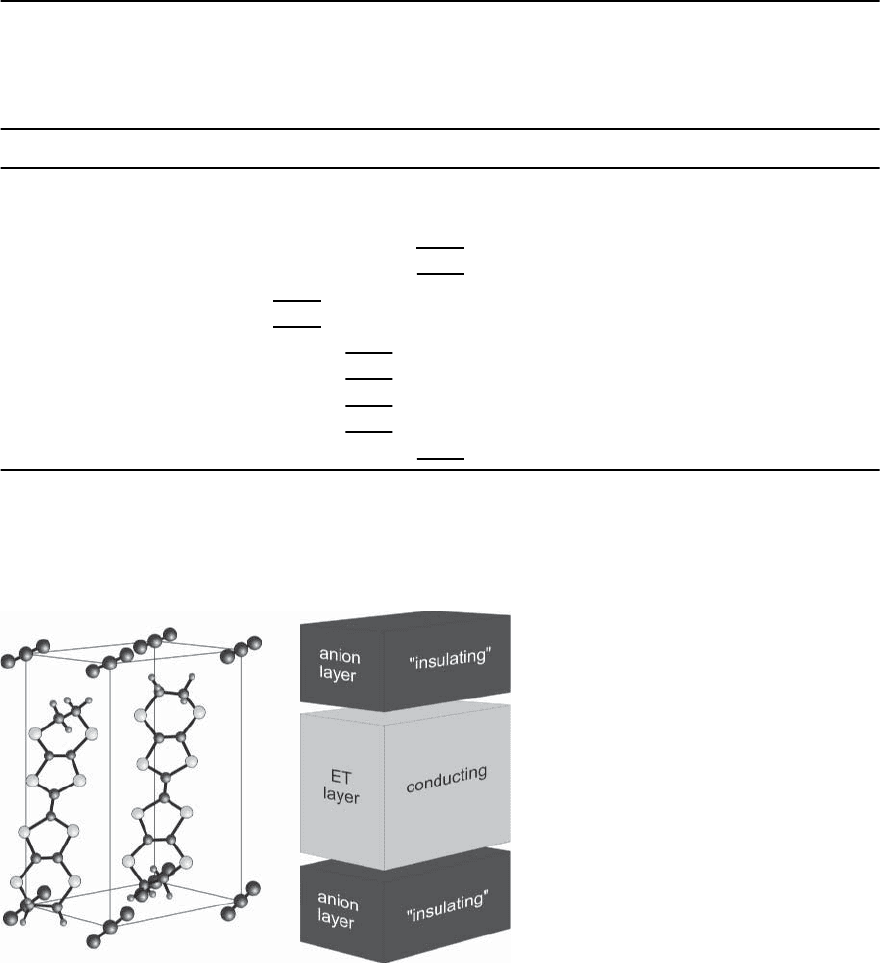
13 Unconventional Superconductivity in Novel Materials 701
Table 13.6. Crystallographic data and T
c
for some organic metals based on the donor molecules TMTSF and ET. Z is the
number of formula units per unit cell. For T
c
the usually stated values are given independent from the experimental de-
termination. The actual thermodynamic values may differ slightly. For the ET-based compounds the out-of-plane lattice
parameter is underlined
Compound sp-gr. a(Å) b (Å) c(Å) ˛(
◦
) ˇ(
◦
) (
◦
) ZT
c
(K)
(TMTSF)
2
PF
6
P
¯
1 7.297 7.711 13.522 83.39 86.27 71.01 1 [404] 0.9
a
(TMTSF)
2
ClO
4
P
¯
1 7.266 7.678 13.275 84.58 86.73 70.43 1 [430] 1.2
ˇ-(ET)
2
I
3
P
¯
1 6.615 9.100 15.286 94.38 95.59 109.78 1 [431,432] 1.4
ˇ-(ET)
2
IBr
2
P
¯
1 6.593 8.975 15.093 93.79 94.97 110.54 1 [433] 2.8
-(ET)
2
I
3
P2
1
/c 16.387 8.466 12.832 90 108.56 90 2 [434] 3.5
-(ET)
2
Cu(NCS)
2
P2
1
16.256 8.456 13.143 90 110.28 90 2 [435] 10.4
-(ET)
2
Cu[N(CN)
2
]Br Pnma 12.949 30.016 8.539 90 90 90 4 [391] 11.5
-(ET)
2
Cu[N(CN)
2
]Cl Pnma 12.977 29.977 8.480 90 90 90 4 [392] 12.8
b
˛-(ET)
2
KHg(SCN)
4
P
¯
1 10.082 20.565 9.933 103.70 90.91 93.06 2 [436] –
c
˛-(ET)
2
NH
4
Hg(SCN)
4
P
¯
1 10.091 20.595 9.963 103.67 90.47 93.30 2 [437] 1.1
ˇ
-(ET)
2
SF
5
CH
2
CF
2
SO
3
P
¯
1 9.260 11.635 17.572 94.69 91.70 103.10 2 [438] 5.2
a
this value was reported in [388] for a pressure of 12 kbar. A pressure of ∼ 6 kbar is however sufficient
to suppress the SDW state and enable superconductivity with T
c
≈ 1.1 K. See, e.g., [439,440]
b
at a pressure of ∼ 0.3kbar
c
recently superconductivity with T
c
≈ 100 mK was reported to occur at 2.5 kbar [441]
Fig. 13.67. Characteristic layered structure of
the quasi-two-dimensional (2D) organic met-
als, exemplified by the crystal structure of ˇ-
(ET)
2
I
3
. The short distances between the sulfur
atoms ofdifferent ET molecules result in a good
conductivity withintheETlayers.TheETlayers
are separated by the poorly conducting anion
layers, schematically shown on the right side
the charge transfer lead to partially filled molecu-
lar bands, enabling metallic conductivity. The anion
layers are sandwiched between the highly conduct-
ing ET layers.This results in very strong anisotropies
of the physical properties parallel and perpendicular
to the layers. The electrical resistivity perpendicular
tothelayersislargerbyabout3−6ordersofmag-
nitude than for electronic transport within the ET
layers [389,399]. One should mention, however, that
the exact value of this anisotropy is difficult to deter-
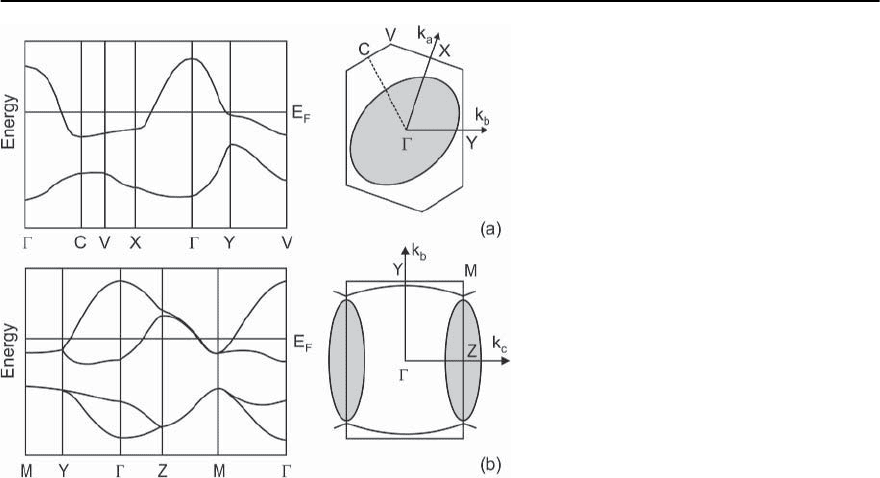
702 M.B. Maple et al.
Fig. 13.68. Calculated energy dispersions and
Fermi surfaces for (a) ˇ-phase and (b) -phase
ET salts (after [443,444] and [445])
mine since any dislocation disturbing the in-plane
transport will immediately lead to an enhanced in-
plane resistance [401,442].This 2D structure,which
is also reflected in the superconducting properties, is
observed in all ET phases and resembles that of many
layered cuprates, such as Bi
2
Sr
2
CaCu
2
O
8−ı
[396].
Although the layered structure occurs in all ET-
basedsuperconductors,thevarying in-plane packing
motifs of the organic molecules lead to different 2D
electronic structures. The overlap integrals vary con-
siderably depending on whether the ET molecules
are aligned face-to-face or side-by-side [443,444].
The in-plane transfer energies can be obtained from
these overlap integrals that, together with the known
crystal structures, allow the in-plane electronic band
structures to be calculated using the rather simple,
but well-established extended H¨uckel tight-binding
approximation. Two examples of the resulting en-
ergy dispersions and of the in-plane Fermi surfaces
are shown in Fig. 13.68.
For the ˇ phase,one electron per unit cell is trans-
ferred to the anion leaving the highest occupied
molecular orbital half filled. The nearly isotropic in-
plane overlap integrals lead to an almost circular
free-electron-like FS (Fig. 13.68(a)) [443, 444]. The
validity of this result has been verified by measure-
ments of magnetic quantum oscillations and angular
dependent magnetoresistance oscillations [410,446].
Indeed, only one closed orbit with the predicted area
(shaded area in Fig. 13.68(a)) and only slightly more
cornered shape [446, 447] could be reconstructed
from the data.
For the phase, the resulting FS is almost as sim-
pleasfortheˇ phase. Here, the ET molecules form
dimers where adjacent pairs in the plane are rotated
by approximately 90
◦
with respect to each other.This
doubles the unit cell, resulting in two transferred
electrons on two highest occupied molecular orbitals
(see the dispersion relation in Fig. 13.68(b)). The re-
sulting FS again resembles the free-electron picture
wheretheFScutsthefirstBrillouinzonewithsmall
gaps opening at the zone boundary due to Bragg re-
flections [445]. In fact, for -(ET)
2
Cu(NCS)
2
,larger
gaps at the zone boundary are found due to the
lack of a center of symmetry [448].Again, de Haas–
van Alphen (dHvA) and Shubnikov–de Haas (SdH)
experiments confirm the predicted band structures
for the -phasematerialsaswellasformostother
phases. However, the calculated effective masses are
often much smaller than the experimental values,

13 Unconventional Superconductivity in Novel Materials 703
sometimes close to the free-electron value. This is
usually ascribed to the fact that many-body effects
like electron–electron and electron–phonon interac-
tions are typically not included in band-structure
calculations.For moredetails on Fermi-surfacestud-
ies, see the reviews in [410,446,449].
Although the extended-H¨uckel treatment has
been successful in describing the in-plane electronic
band structure of organic metals and superconduc-
tors, it leaves the interlayer band structure unclear.
The large separation of the conducting organic lay-
ers by relatively thick anion layers has led to the
question of whether a real 3D Fermi surface exists
at all. When the interlayer transport is incoherent,
i.e.,when an electron loses its phase information be-
tween successive tunneling processes, no Bloch state
can evolve and the band picture breaks down [450].
Although there is no experimental proof for this sce-
nario, certain experimental features can be utilized
to verify the coherent transport and the existence of
a 3D Fermi surface [450,451].
The most direct test of the 3D nature of the FS,
which even gives a number for the interlayer trans-
fer integral t
⊥
, is the detection of nodes in mag-
netic quantum oscillations.Figure13.69(a) showsthe
dHvA signal for ˇ-(ET)
2
IBr
2
. The fast dHvA oscilla-
tions visible in the magnetization can be ascribed to
the closed FS shown in Fig.13.68(a).The existence of
a corrugatedFS,sketched in the inset of Fig.13.69(a),
results in two slightly different extremal orbits for
the field H normal to the layer, leading to the beat-
ing nodes observed in the dHvA signal. At certain
angles of the field relative to the normal to the
ET planes, only one extremal orbit perpendicular to
H remains and, consequently, no beating node ap-
pears in the dHvA signal. The careful determination
of the angular dependence of these nodes allows a
reliable extraction of t
⊥
[452]. For ˇ-(ET)
2
IBr
2
with
a Fermi energy E
F
≈ 0.11 eV, the transfer integral
t
⊥
=0.4 meV is obtained.
Although solid proof exists for the coherent mo-
tion of electrons in band or Bloch states in ˇ-phase
ET salts, such evidence is missing for other or-
ganic metals. For example, the magnetization of ˇ
-
(ET)
2
SF
5
CH
2
CF
2
SO
3
shows sawtooth-like dHvA os-
cillations which follow the behavior expectedfor a 2D
metal with fixed chemical potential almost perfectly
(Fig. 13.69(b)) [453]. Furthermore, from the absence
of any beating node in dHvA and SdH oscillations,
which start at about 1.4 T deep in the superconduct-
ing state [454], any possible FS corrugation must be
extremely small. Indeed, additional tests for the ex-
istence of a 3D FS failed for this material [455],mak-
ing it a likely candidate for the 2D metal with inco-
herent interlayer transport envisioned by McKenzie
and Moses [450].Along these lines, deviations from
the conventional Bloch–Boltzmann transport theory
were observed in the interlayer magnetoresistance,
i.e., a field-induced metal-insulator transition was
found [456]. In spite of these highly unusual proper-
ties which contradict Fermi-liquid theory, the inter-
layer resistanceatH = 0 ismetallic overthe whole in-
vestigated temperature range (see Fig. 13.70) and the
measured quantum oscillations are consistent with
an in-plane Fermi liquid. A possible realization of
the FS of ˇ
-(ET)
2
SF
5
CH
2
CF
2
SO
3
is depicted in the
inset of Fig. 13.69(b).
For some organic superconductors, such as -
(ET)
2
Cu[N(CN)
2
]Br, the interlayer resistivity in-
creases upon cooling, reaching a maximum be-
fore metallic behavior sets in at lower temperature
[389,399]. There were speculations that this might
be caused by antiferromagnetic fluctuations, espe-
cially since NMR measurements of the spin-lattice
relaxation rate 1/T
1
revealed a maximum in 1/(t
1
T)
close to the temperature where the maximum in R
was observed (see also the dashed line in Fig. 13.76
below) [457,458].However, as was shown in a recent
thorough study, a significant part of the scattering
contribution giving rise to the anomalous resistiv-
ity maximum is extrinsic in nature [459]. For low-
resistance variants of -(ET)
2
Cu[N(CN)
2
]Br, grown
by a different preparation route [459], no resistance
maximum occurs. This metallic behavior all the way
down from room temperature is presented for such
a -(ET)
2
Cu[N(CN)
2
]Br sample in Fig. 13.70, where
the metallic resistance for two other organic super-
conductors is shown as well.
At high temperature, there is no generic T depen-
dence forthe differentorganic metals.Towards lower
T, however, the interlayer resistivity can fairly well
be described by =
0
+ AT
2
(inset of Fig. 13.70).
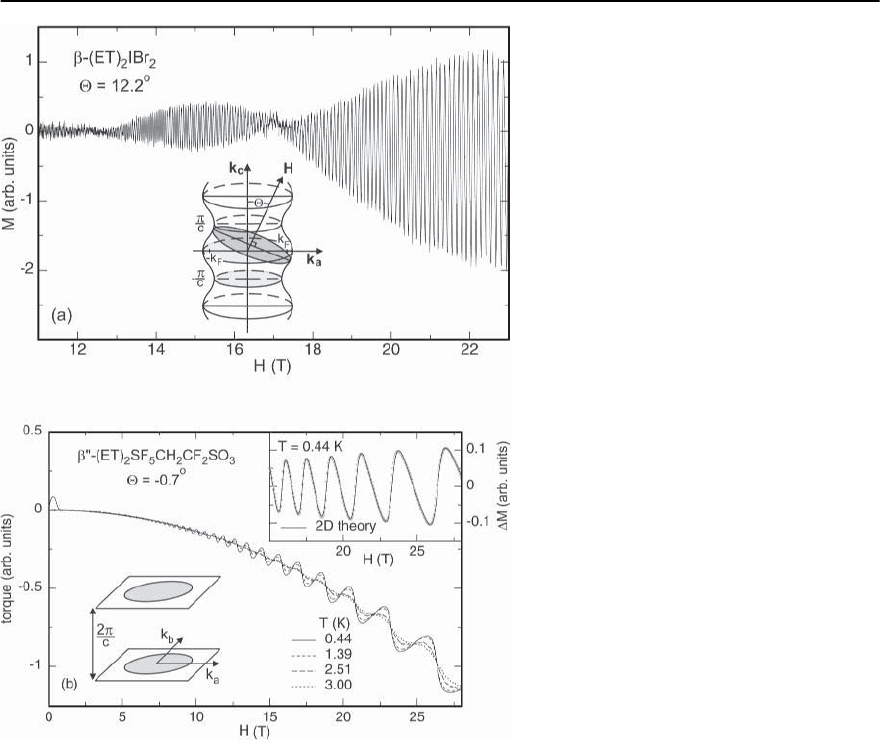
704 M.B. Maple et al.
Fig. 13.69. (a) de Haas–van Alphen (dHvA) os-
cillations in the magnetization of ˇ-(ET)
2
IBr
2
at T =0.4 K. The nodes in the signal are caused
by the slightly corrugated FS perpendicular to
theconducting ETplanes.The schematicsketch
in the inset greatly exaggerates this corruga-
tion.(b) Torque as a function of magnetic field
of ˇ
-(ET)
2
SF
5
CH
2
CF
2
SO
3
. The dHvA signal
(open circles in the upper inset) can be de-
scribed almost perfectly by a 2D theory (solid
line in the upper inset)TheFScanberegarded
as ideally 2D (lower inset)
This T
2
behavior, which is also observed for many
other organic metals [389], is usually taken as a
sign of a well-behaved Fermi liquid where scatter-
ing is dominated by electron-electron interactions.
However, although electronic correlations certainly
are present in these low-dimensional metals, the
wide temperature range over which the T
2
behav-
ior can be found is not typical. Usually, this tem-
perature dependence of can only be observed at
very low temperatures. The coefficient A depends on
the strength of the electron–electron interaction and
is roughly proportional to
2
,where is the Som-
merfeld coefficient of the specific heat [188]. As dis-
cussed in Sect. 13.3, for narrow-band systems like
heavy-fermion metals, where electronic correlations
are undoubtedly much more dominant than for or-
ganic metals,A/
2
≈ 10
−5
§ cm(mol K/J)
2
.Fortran-
sition metals,A/
2
is even a factor 100 smaller. Using
a Sommerfeld coefficient ≈ 25 mJ/mol K
2
derived
from the specific heat of the organic metals (see be-
low), A ≈ 6 × 10
−9
§ cm K
−2
would be expected for
narrow-band metals. This is 6 to 8 orders of mag-
nitude smaller than is actually observed for the or-
ganic metals (A ≈ 4m§ cm K
−2
for the -phase salts
and about 100 times larger for the ˇ
salt). When
using the in-plane resistivity data, A is still at least
two orders of magnitude larger than expected. Thus,
it seems highly questionable to seek the origin of
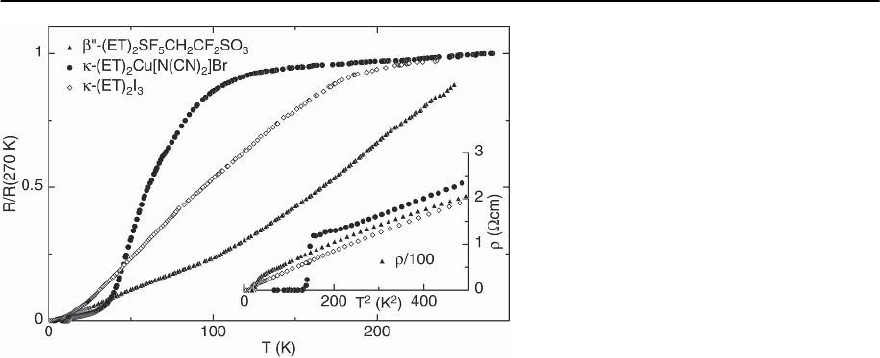
13 Unconventional Superconductivity in Novel Materials 705
Fig. 13.70. Temperature dependence of the in-
terlayer resistance R,normalizedbyR at 270
K, for three different organic superconductors.
The inset shows the resistivity as a function
of T
2
.Notethat for ˇ
-(ET)
2
SF
5
CH
2
CF
2
SO
3
has been divided by 100
this T
2
behavior of the resistivity solely within the
electronic system [460]. Scattering of 2D electrons
at phonons might be the relevant mechanism. Inter-
estingly, a number of other novel superconductors,
including MgB
2
and the borocarbides, reveal a T
2
dependence as well, hinting at a possible common
mechanism.
A further point which should be noted is the ex-
traordinarily high interlayer resistivity of the or-
ganic metals.For -(ET)
2
Cu[N(CN)
2
]Br, ≈ 1 § cm
just above T
c
, which is about a factor of 10
6
larger
than for lead at T
c
.Forˇ
-(ET)
2
SF
5
CH
2
CF
2
SO
3
, is
another factor ∼ 50 larger. The mean-free path de-
rived from these values of according to the usual
transport theory is much smaller than the inter-
atomic distances.This effect becomes even more pro-
nouncedtowardshigher temperatures.Again onehas
to ask, in analogy to the high-T
c
cuprates, whether
the interlayer transport can be understood in terms
of the usual Fermi-liquid theory.
13.4.3 Superconducting-State Properties
The organic superconductors, as well as all other
novel superconductors discussed here, are strongly
type-II superconductors. The lower critical fields,
H
c1
, of the organic superconductors are only a few
mT and the upper critical fields, H
c2
,areintheTesla
range. These fields depend strongly on the direction
of the applied field.For H applied within the planes,
perpendicular to the least-conducting direction, H
c2
often exceedsthePauli paramagnetic limit [16,17].As
will be discussed below in more detail, this is taken
as an indication for triplet pairing in the 1D ma-
terials. For the 2D organic superconductors, on the
other hand, many-body effects seem to explain the
observed moderate H
c2
enhancement.
Above a certain threshold field H
irr
within the
Shubnikov phase, the magnetic flux can move freely
leading to dissipative phenomena and phase dia-
grams similar to those studied in great detail for
the high-T
c
materials. In spite of their moderate val-
ues of T
c
, the layered structure and the high purity
of the organic superconductors lead to a large re-
versible range in the mixed state. In contrast to the
high-T
c
superconductors,the upper critical fields of
the organic superconductors are relatively low and
more experimentally accessible. Thus, we can con-
veniently study the complete superconducting phase
diagrams and the rich physics of the vortex phase.
Indeed, as previously observed in high-T
c
cuprates,
the first-order vortex-lattice melting transition close
to H
irr
was resolved in two -phase ET superconduc-
tors by means of sophisticated magnetization exper-
iments [461,462].Anothercommon featureobserved
for the highly anisotropic cuprates [463] and the
equally anisotropicET superconductorsis the occur-
rence of Josephson plasma resonances in magneto-
optical experiments [464].
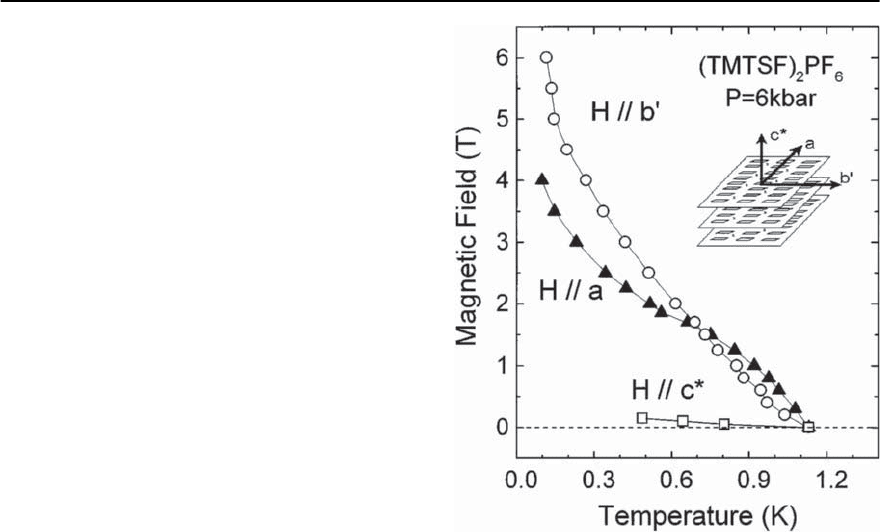
706 M.B. Maple et al.
1D Organic Superconductors
All the known 1D Bechgaard superconductors, ex-
cept for (TMTSF)
2
ClO
4
, need pressure above at
least 6 kbar to become superconducting at transition
temperatures around 1 K. The amount of pressure
needed to suppress the insulating ground state de-
pends on the quality of nesting, i.e., on the electronic
energy which can be gained at a Peierls transition. In
other words, a certain degree of two-dimensionality
is necessary to allow superconductivity to appear. In
fact, an almost linear relationship has been observed
between the lattice parameter b (see Fig. 13.63) and
the critical pressure which suppresses the SDW state
and induces superconductivity [465].
A further increase in pressure P results in a rapid
decreaseof T
c
onthe orderof dT
c
/dP ≈ 0.1K/kbar.A
decreasing T
c
with pressure is a common feature in
many conventional superconductors, however, with
a much smaller dT
c
/dP. This can be explained by
stiffening of the lattice under pressure that results in
an increase of the average phonon frequency. This
lattice stiffening is expected to be especially strong
in soft organic crystals. Since in conventional super-
conductors T
c
depends sensitively on the phonon fre-
quency, T
c
decreases.
For the highly anisotropic organic metals, a cor-
respondingly strong directional dependence of the
critical fields is observed. The lowest upper critical
fields are found for H aligned along the c
∗
direc-
tion (H
c2
≈ 0.16 T for (TMTSF)
2
ClO
4
) [389]. For
this fieldorientation,orbitaleffects, i.e.,diamagnetic
currents running in the ab
plane, limit H
c2
.Formag-
netic fields along b
and a, this orbital limiting is
largely suppressed due to the short c
∗
-axis coher-
ence length. Consequently, in early experiments up-
per critical fields of ∼ 2and∼ 2.8 T, respectively,
were reported [466].Thisresultwasdiscussed in light
of a possible Pauli-limited H
c2
, suggesting that the
Cooper pairs in the Bechgaard salts are in the sin-
glet state. Neglecting spin-orbit coupling and many-
body effects, the Pauli (or Clogston) limit is given
by H
p
=(1.85 T/K)T
c
[16, 17], i.e., H
p
≈ 2.3 T for
(TMTSF)
2
ClO
4
with T
c
=1.25 K.
Since H
c2
displays a strong anisotropy, an exact
alignment of the field with respect to the princi-
pal axes, a, b
,andc
∗
is required for its correct de-
Fig. 13.71. H − T phase diagram of (TMTSF)
2
PF
6
at an ap-
plied pressure of 6 kbar for fields aligned along the a, b
,
and c
∗
directions (see inset)Thedataareextractedfrom
electrical-resistance measurements [439,440]
termination. Indeed, by carefully aligning H. Lee et
al. proved impressively that for (TMTSF)
2
PF
6
under
pressure, H
c2
definitely exceeds the Pauli paramag-
netic limit (Fig. 13.71) [439,440]. This occurs for H
oriented along the a direction but even more pro-
nounced for H aligned along the b
direction. For
these field orientations, the orbital motion of the
charge carriers is greatly suppressed due to the weak
interplane transfer.TheH −T phase diagram was ex-
tracted from electrical-resistance data. The validity
of this determination has recently been verified for
(TMTSF)
2
ClO
4
utilizing torque magnetization mea-
surements [467]. The observed strong H
c2
enhance-
ment triggered the proposal by Lebed of triplet or
p-wave pairing occurring in the 1D organic super-
conductors [468].
In order to provide further evidence for triplet
pairing,ajointeffortbyseveral different groupstack-
led the challenging task of performing NMR mea-
surements under pressure at dilution-refrigerator
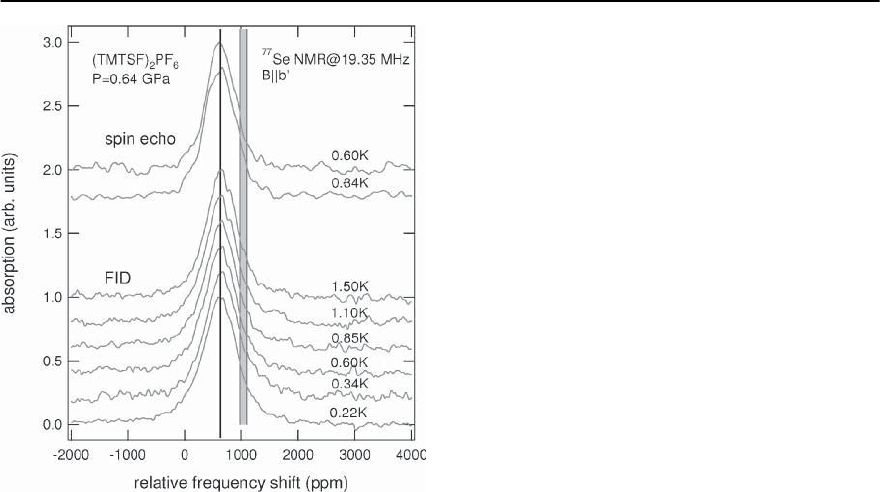
13 Unconventional Superconductivity in Novel Materials 707
Fig. 13.72.
77
Se NMR spectra below and above T
c
for
(TMTSF)
2
PF
6
with a magnetic field H =2.38 T aligned
along the b
-axis. The center of the NMR peak is virtu-
ally independent of temperature (solid line), whereas the
hashed r egion marks the expected range where it should
occur for a singlet ground state below T
c
[440,469]
temperatures [469,470].The resulting
77
Se NMR data
revealed no observable change in the Knight shift be-
tween the normal metallic and the superconducting
state (Fig. 13.72). This provided strong support for
triplet pairing since for singlet Cooper pairs with
antiparallel spins, the Knight shift, which depends
linearly on the electron-spin susceptibility, should
drop rapidly below T
c
.Indeed,the unchanged Knight
shift observed previously for Sr
2
RuO
4
[321] is one of
the primary pieces of evidence for a triplet state in
this superconductor.Stimulated by the experiments
for (TMTSF)
2
PF
6
, Lebed suggested a triplet vector
order parameter with the spins oriented along the b-
axis [471].This proposal fitsnicely withthe observed
features that a magnetic field applied along the b
di-
rection cannot destroy superconductivity. It further
predicts a finiteenergy gap over the whole FS,which
is consistent with thermal-conductivity results for
(TMTSF)
2
ClO
4
[472]. In another work, spin-triplet
f -wave-like pairing was suggested, which should be
in competition with singlet d-wave pairing [473]. It
should be noted that previous measurements already
showed a strongly enhanced H
c2
for (TMTSF)
2
AsF
6
[474]. This and the suppression of superconductiv-
ity by defects and by chemical substitution moti-
vated early suggestions of a possible p-wave symme-
try in the 1D organic metals [475,476].Very recently,
however, the same group that performed the NMR
shown in Fig. 13.72 carefully checked their results.
In (TMTSF)
2
ClO
4
they found a clear change of the
Knight shift at low-enough magnetic fields in the su-
perconductingstate[711].This clearlyprovesthesin-
glet nature of the Cooper pairing. It remains a chal-
lenge to understand the high-field zero-resistance
state in the Bechgaard salts where the Knight shift
remains as in the normal state.
Although the experimental data now point to a
singletscenario,noconsensuson thenatureof super-
conductivityin the Bechgaard salts has been reached
[477]. In other theoretical models it was shown that
even conventional s-wave pairing with an appropri-
ate anisotropic orbital momentum may lead to the
critical-field curve shown in Fig. 13.71 [478]. An-
other possibility is an unconventional d-wave state
where the line nodes of the d-wave gap function are
assumed to be eliminated by the anion ordering in
(TMTSF)
2
ClO
4
[479].
2D Organic Superconductors
Equally intense and even more controversial is the
discussiononthe nature of the superconducting state
in the 2D organic superconductors.However, before
discussing this issue in more detail some principal
superconducting properties as well as some high-
field peculiarities will be presented.
Supercond u cting Properties
A typical magnetic phase diagram of the 2D
organic superconductors is exemplified for -
(ET)
2
Cu[N(CN)
2
]Br in Fig. 13.73. The magnetic field
isappliedperpendicular totheETplanes.H
c1
andH
c2
are obtained from dc-magnetization measurements,
M
dc
,whereasH
irr
is derived from measurements of
ac susceptibility,
ac
[480,481].The magnetization is
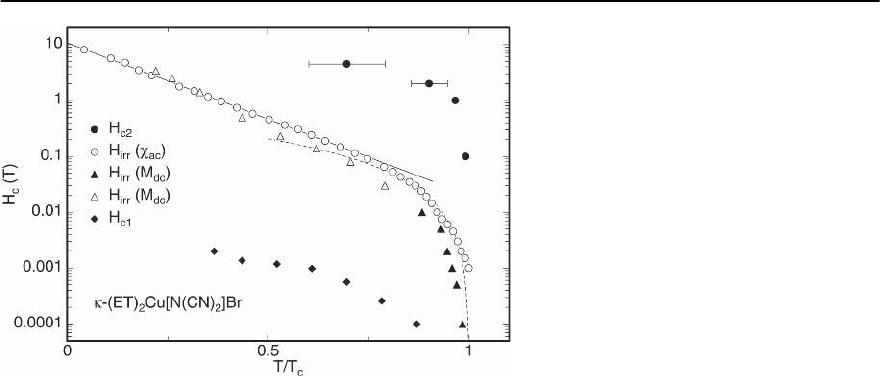
708 M.B. Maple et al.
Fig. 13.73. Temperature dependences of H
c1
,
H
c2
, and of the irreversibility field, H
irr
of -
(ET)
2
Cu[N(CN)
2
]Br. The data points (•, )are
from [480]. The solid line is an exponential fit,
H
irr
∝ exp(−AT /T
c
), at low T.AT
3/2
depen-
dence near T
c
is denoted by the dashed line
broadened considerably in fields due to supercon-
ducting fluctuations, and a scaling analysis was per-
formed in order to obtain H
c2
(Fig. 13.73) [480],in a
manner similar to that done for the high-T
c
cuprates.
The lower critical field is often extracted from
the first deviation from perfect diamagnetism. For
the strongly type-II superconductors, like the or-
ganic and high-T
c
superconductors, however, this
may overestimate H
c1
since above H
c1
,fluxcanonly
penetrate into the sample over a final energy barrier.
This leads to magnetic relaxation effects which be-
come increasingly slow close to H
c1
[399,481]. Since
no time dependence of M is expected to occur in the
Meissner state,H
c1
is defined as the fieldat whichthe
magnetic relaxation vanishes [481].The H
c1
data are
depicted in Fig. 13.73.
For -(ET)
2
Cu[N(CN)
2
]Br, an upper critical field
of (12±2) T and a lower critical fieldof(3±1) mT for
T = 0 can be estimated. From these results the ther-
modynamic critical field H
c
≈ 100 mT, the in-plane
coherence length
≈ 5 nm, and the Ginzburg–
Landau parameter ≈ 100 can be derived. With
an average in-plane lattice parameter on the order
d ≈ 1nm,
/d is approximately 5, which is con-
siderably smaller than the value of ∼10
3
typical for
pure metals, but comparable to what is found in
high-T
c
cuprates and other “exotic” superconduc-
tors. The BCS coherence length is given by
0
=
0.18v
F
/k
B
T
c
≈ 6.7 nm, using an estimate of the
Fermi velocity v
F
≈ 5.6 × 10
4
m/s from dHvA data.
With a mean-free path l of 200 to 400 Å, determined
from magnetic quantum oscillations,this organic su-
perconductor is just barely in the clean limit with
l/
0
≈ 5.In this case,oneexpects
=0.74
0
≈ 5nm
which agrees quite well with the experimental value
for
. For fields parallel to the ET layers, H
c1
is con-
siderably smaller than the earth’s field, making it
nearly impossible to measure [482]. From the esti-
mated value of H
c2
at T = 0 for in-plane field orien-
tations, an approximate interplane coherence length
of
⊥
≈ 0.5nm can be determined, which is much
smaller than the layer distance of about1.6 nm [396].
For other 2D organic superconductors,similar super-
conducting parameters have been found [402].
The physics of vortex dynamics in type-II su-
perconductors, extensively studied for the high-T
c
cuprates, has also been investigated in detail for the
organic metals.Abovethe threshold field H
irr
of type-
II superconductors, vortices are free to move and,
therefore, the magnetization is reversible.Below H
irr
,
the vortices are pinned, resulting in magnetic hys-
teresis, a diamagnetic ac-susceptibility signal, and a
vanishing electrical resistivity. Since the depinning
of the vortices is an activated process, slightly differ-
ent values for H
irr
are obtained depending on the
method used and the criterion applied. Nonethe-
less,the gross temperature and angular dependences
of H
irr
are largely unaffected by these unambigu-
ities [481, 482]. The H
irr
data in Fig. 13.73 show a
clear crossover at T/T
c
≈ 0.75, independent of the
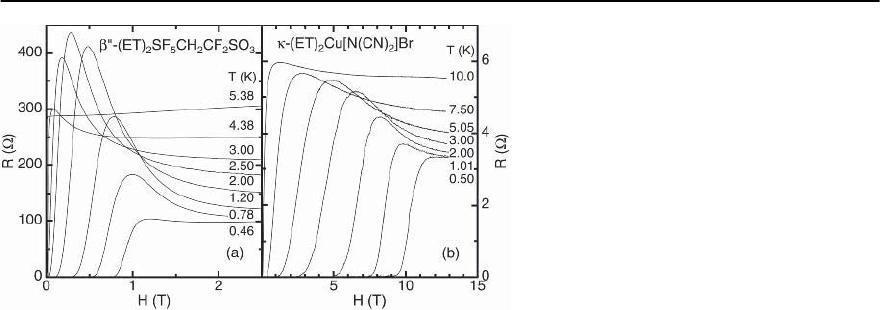
13 Unconventional Superconductivity in Novel Materials 709
Fig. 13.74. The interlayer magnetoresistance
of (a) ˇ
-(ET)
2
SF
5
CH
2
CF
2
SO
3
and (b) -
(ET)
2
Cu[N(CN)
2
]Br for fields applied perpen-
dicular to the ET planes with strong peaks be-
fore superconductivity occurs
method used to obtain the data. The same behav-
ior has been observed for another -phase organic
superconductor as well [483]. A crossover from 3D
vortex fluctuations to 2D fluctuations is predicted at
amagneticfieldH
cr
≈ 4¥
0
/
2
d
2
≈ 0.08 T, where
¥
0
=2.07×10
−15
Tm
2
is the magnetic-flux quantum,
d ≈ 1.6 nm is the interlayer distance, and ≈ 200 is
the anisotropy parameter estimated from magnetic-
torque measurements for -phase superconductors
[484,485]. This prediction is in excellent agreement
with the experimental value of H
cr
≈ 0.05 T.
Thermally activated 3D vortices are believed to
be responsible for the power-law T dependence of
H
irr
∝ T
3/2
close to T
c
(Fig.13.73) [486],whereas the
low-temperature exponential behavior can be under-
stood by the breakdown of proximity-induced su-
perconductivity (see [481] for details). This suggests
that superconductivity is induced in the normal-
conducting anion layers by the superconducting ET
layers. Above a certain threshold field H
irr
for this
proximity-induced superconductivity,thesupercon-
ducting layers are effectively decoupled, and the vor-
tices are weakly pinned 2D objects (pancake vor-
tices). Measurements of the angular dependence of
H
irr
have verified that in the low-T 2D pinning
regime, H
irr
() exhibits 2D behavior as predicted
by Tinkham for H
c2
() of 2D films [204,487]. Close
to T
c
, the Lawrence–Doniach model [488] for 3D
anisotropic superconductors describes the data well
[481,483].
In contrast to most conventional superconductors,
the short coherence lengths and large anisotropies
in 2D organic superconductors lead to strong ther-
mal fluctuations close to T
c
, clearly visible in the
electrical resistivity, the diamagnetic signal, and the
specific heat. Estimates for the width of the tem-
perature regime where thermal fluctuations are rel-
evant can be made using the Ginzburg criterion,
G = |T − T
c
|/T
c
∝ (T
c
H
−2
c
−2
−1
⊥
)
2
.FortheETsu-
perconductors with T
c
∼ 10 K, a value of G ≈ 10
−2
results,which is comparable to values found for high-
T
c
cuprateswhere the larger T
c
iscompensated by the
correspondingly larger thermodynamic critical field
H
c
[395,396,399,402].Forelemental superconductors,
G is of the order 10
−8
due to the much larger coher-
ence lengths. The fluctuation width becomes much
broader in applied magnetic fields, an effect visible
in resistivity and magnetization data,and it has been
studied extensively in both organic and high-T
c
su-
perconductors [389,396].
One peculiar feature of the 2D organic supercon-
ductors is the occurrence of pronounced peaks in
the interlayer resistance R close to the supercon-
ducting phase boundary (Fig. 13.74), which is be-
lieved to be caused by thermal fluctuations. With
decreasing field, a peak in R is observed before su-
perconductivity sets in. This peak is observed over
a range of temperatures up to T
c
.Althoughanum-
ber of models have been suggested (see [395,399]for
an overview), a feasible explanation is based on the
fluctuation-induced decrease of the normal density
of states at the Fermi level. Combined with the other
conductivity contributions caused by fluctuations
(Aslamazov–Larkin and Maki–Thompson contribu-
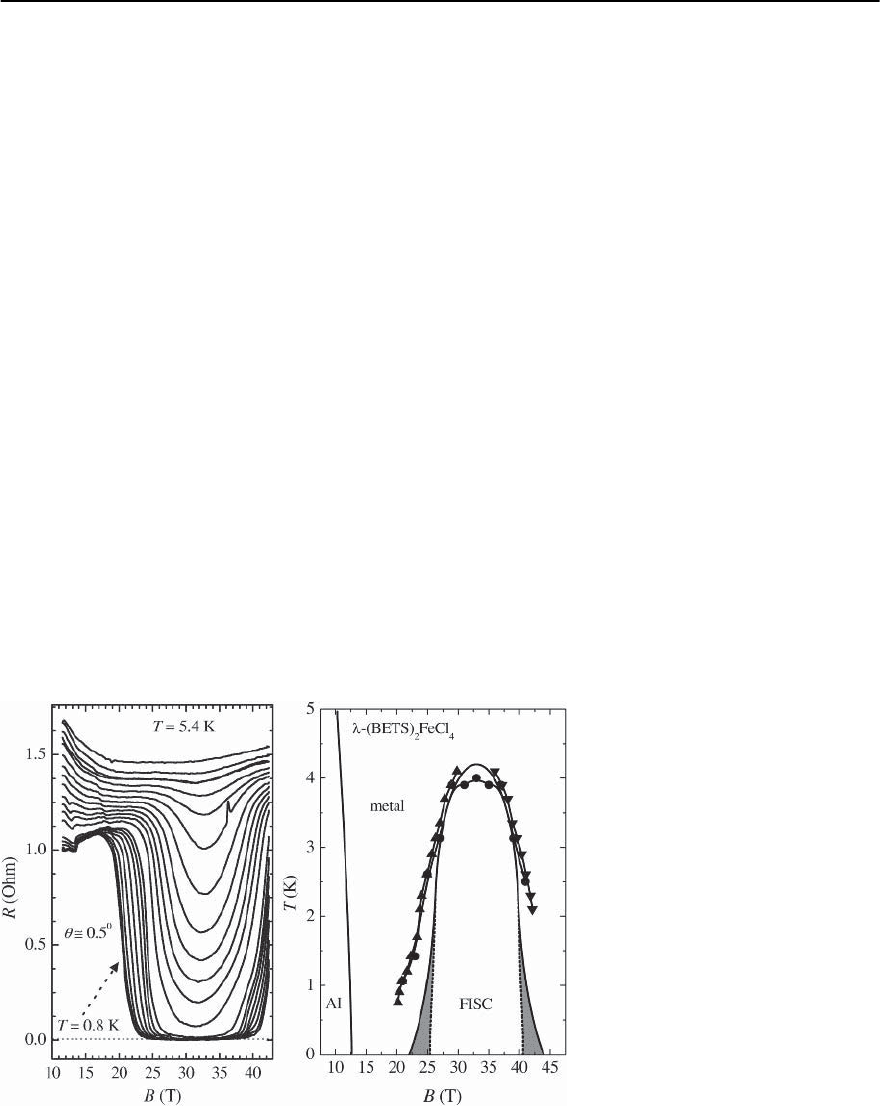
710 M.B. Maple et al.
tions), the observed behavior can be qualitatively re-
produced taking into account the high anisotropy of
the superconductors[395,489,490].Nevertheless,the
origin of this peak effect in the resistance measure-
ments is still not well understood.
Measurements of the physical properties of 2D
organic superconductors in high magnetic fields re-
veal a number of intriguing features. For the or-
ganic superconductor -(ET)
2
Cu(NCS)
2
,measure-
ments using a tuned-circuit differential suscep-
tometer revealed a change in the vortex rigidity
at in-plane magnetic fields of about 22 T [491].
This has been suggested to indicate the onset of
a Fulde–Ferrell–Larkin–Ovchinnikov (FFLO) state.
This FFLO state is predicted to evolve at high mag-
netic fields when an attractive interaction between
the Zeeman-split spin-up and spin-down quasipar-
ticles leads to pairs with nonzero total momen-
tum [238, 239]. (See also the discussion above for
CeCoIn
5
.) 2D organic superconductorsare good can-
didates for this scenario when the magnetic field is
applied in plane, which prevents the appearance of
orbital pair-breaking effects. Indeed, very recently
specific-heat measurements revealed clear thermo-
dynamic evidence for the existence of an FFLO state
in -(ET)
2
Cu(NCS)
2
[712].
A second fascinating aspect of the high-field work
on organic superconductors is the observation of
field-induced dissipation-less diamagnetic currents
in the organic metal ˛-(ET)
2
KHg(SCN)
4
[492,493].
This material is now believed to be in a CDW state
at low temperatures (below 8 K) and fields below
about 23 T [494,495];the material stays metallic with
only a partial nesting of the 1D FS sheets. Early
experimental data were interpreted in favor of a
SDW state (see [410] for details). At higher fields
above 23 T, when the Zeeman splitting deteriorates
the nesting condition for the spin-up and spin-down
bands, a spatially modulated incommensurate so-
called CDW
x
state is believed to evolve (analogous to
the FFLO statefor superconductors) [496].Itiswithin
this high-field, low-temperature state that proper-
ties resembling a superconducting vortex state ap-
pear.More precisely,a field-induceddiamagnetic sig-
nal [493] and hysteresis loops comparable to the
irreversible region of the Shubnikov phase are ob-
served [492,494,497]. Although Fr¨ohlich supercon-
ductivity has been suggested [401], further justifi-
cation of this proposal is absent. Recently, Harri-
son has suggested that the coexistence of the CDW
with a strongly field-dependent orbital magnetiza-
tion, caused by the Landau quantization of the 2D
Fig. 13.75. Left panel: In-plane field de-
pendence of the resistance R of -
(BETS)
2
FeCl
4
for different tempera-
tures from 0.8to5.4K. Right panel:
The H −T phase diagram indicates that
after the suppression of an antiferro-
magnetic insulating (AI) low-field state
with magnetic field, field-induced su-
perconductivity (FISC), referred to in
the text as magnetic field induced su-
perconductivity (MFIS),is observed be-
tween about 18 to 41 T [500]
